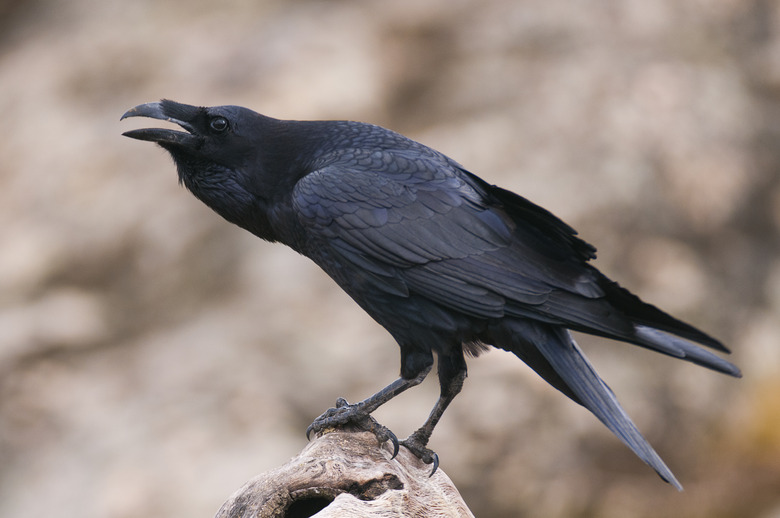How To Identify A Raven Feather
The largest perching bird (passerine) in the world, the common raven is also among the most arresting, combining that hefty size with a glossy, all-black suit of feathers and a deep, commanding croak. In North America, it has a close Southwestern relative in the form of the somewhat smaller Chihuahuan raven.
If you're seeing the bird itself, a raven in North America could only be confused with its littler cousin the crow, but confirming a standalone dropped feather as a raven's is sometimes a bit more difficult – mostly, again, because of crows, though a few other native, dark-plumaged birds could muddy the waters as well.
Raven vs. Crow: Feather Differences on the Birds
Raven
vs. Crow: Feather Differences on the Birds
Common ravens and crows broadly overlap in North America, and it's worth quickly reviewing some of the visual plumage-related differences between these two corvids (as members of the crow and jay family are called) before digging into the identification of an isolated feather. It'll provide a bit of context, at the very least.
After all, there are a couple of feathery features that help you differentiate between ravens and crows, among other important physical criteria – not least the raven's much greater size (as big or bigger than a red-tailed hawk) and much more massive bill.
Proportionately speaking, ravens sport notably longer primaries – the finger-like outer flight feathers – and tailfeathers than crows; a raven's tail appears wedge-shaped compared to the blunter rear end of a crow. Ravens also have heavy, shaggy-looking throat feathers, or hackles, which crows lack.
Crow vs. Raven Feather Identification
Crow
vs. Raven Feather Identification
The feathers of the common raven average larger than those of the American crow – no surprise there, given the significant size disparity between these corvid cousins. That said, there's definitely some overlap, so the dimensions of a pure-black feather would really only be truly diagnostic at the larger extreme.
The raven plumage catalogued in the U.S. Fish and Wildlife Service's "Feather Atlas," which come from an Oregon male, include primaries that reach about 15 inches, secondaries (the shorter flight feathers closer to the bird's body) approaching 9 inches at the longest, and tailfeathers (or rectrices) that all exceed 8 inches.
By comparison, the longest primaries of a male American crow from the same Oregon county in the Feather Atlas collection are about 11 inches, the longest secondaries about 7 inches and the tailfeathers between about 6.5 and 7 inches long.
Color doesn't easily distinguish raven and crow feathers: Both are, of course, black with some bluish, purplish or even greenish iridescence. However, raven feathers tend to be **glossier,** with an oily-looking sheen compared to the relatively duller black of crow feathers.
Other Birds with Raven-esque Feathers
Other
Birds with Raven-esque Feathers
The feathers of some birds superficially similarly plumaged as ravens aren't all that likely to be confused with theirs simply because of size: Blackbirds, for example, are all much smaller than ravens, besides the fact their feathers are usually more colorfully iridescent to boot.
But some larger dark birds pose potential confusion. The flight and tailfeathers of the black vulture, for instance, could conceivably be mistaken for a raven's, though they're dustier-looking, not nearly so glossy black.
If you're lucky enough to be in the small West Coast and Southwestern range of the California condor, you might mistake one of its feathers for a raven's, but they're much bigger – this is one of the largest flying birds in the world, after all.
Using Location to Narrow Down Identification
Using
Location to Narrow Down Identification
While not always an absolute dealbreaker, geographic location can help you refine your best guess when it comes to identifying a large black feather you've found.
In North America, common ravens are most abundant from the Rocky Mountains west to the Pacific coast as well as in the boreal and Arctic zones. In the East, they're more sparsely distributed, though the Upper Midwest, New England and the high Appalachians support decent numbers. Odds are you won't be dealing with raven feathers in, say, the eastern Great Plains or a pinewood on the Deep South's coastal plain.
Generally speaking ravens are much less likely to frequent big North American cities than crows, though there are exceptions – ravens are common sights in San Francisco, for example – and raven numbers appear to be on the increase in many bigger urban areas, even Manhattan. (Ravens do often forage around smaller towns in the West and Far North, where they may rub shoulders with crows while scavenging landfills or fast-food litter.)
Conversely, in the American West where ravens are common, crows generally speaking tend to be scarcer in thinly settled areas and real wilderness. In a desert canyon, sagebrush basin or mountain forest in the backcountry, therefore, you'd definitely err on the raven side of things when scrutinizing an inky feather on the ground.
Cite This Article
MLA
Shaw, Ethan. "How To Identify A Raven Feather" sciencing.com, https://www.sciencing.com/identify-raven-feather-8627586/. 22 November 2019.
APA
Shaw, Ethan. (2019, November 22). How To Identify A Raven Feather. sciencing.com. Retrieved from https://www.sciencing.com/identify-raven-feather-8627586/
Chicago
Shaw, Ethan. How To Identify A Raven Feather last modified March 24, 2022. https://www.sciencing.com/identify-raven-feather-8627586/
